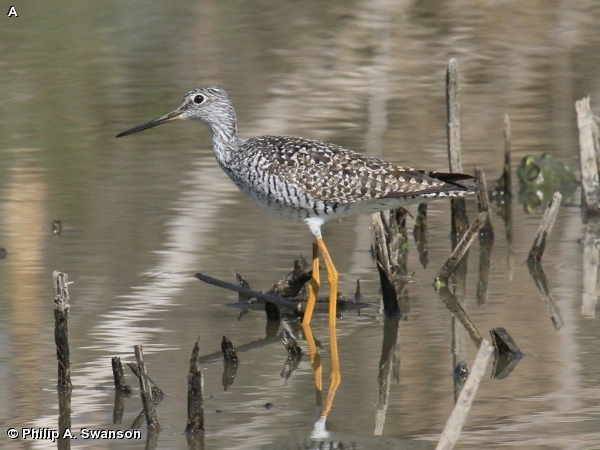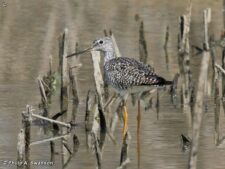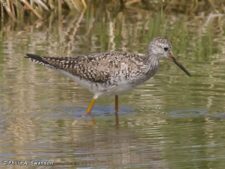
14 inches long. The Greater Yellowlegs is a large shorebird with long legs. The legs are yellow or rarely bright orange. The bill, which may be slightly upturned, is longer than the diameter of its head. The Greater Yellowlegs has brownish-gray and black mottled upperparts, white underparts and a streaked upper breast and sides. The white lower rump and dark-barred tail are easily visible in flight. Breeding birds tend to be more heavily streaked on the head and neck than non-breeding and juvenile birds. During breeding the upper flanks become heavily barred. The smaller but very similar Lesser Yellowlegs (Tringa flavipes) has less streaking and barring on the flanks and a shorter straighter, more slender bill.
The Greater Yellowlegs is common in the Omaha area during spring (April and May) migration and fall migration (late June, July and early September). It might be uncommonly seen in Fontenelle Forest at a wet area such as along the shore of the Great Marsh.
Greater Yellowlegs breed from south-central Alaska to Newfoundland. They spend winters mainly along coasts from Washington State and Virginia southward, and along the Gulf coast. Breeding occurs on tundra and marshy ground. The greater Yellowlegs frequents pools, lakeshores, and tidal mudflats on migration. A group of yellowlegs are collectively known as an “incontinence” of yellowlegs. The call is a sharp “tew” often given three or four times in a row.
Disclaimer: The content of NatureSearch is provided by dedicated volunteer Naturalists of Fontenelle Forest who strive to provide the most accurate information available. Contributors of the images retain their copyrights. The point of contact for this page is: Phil Swanson.



